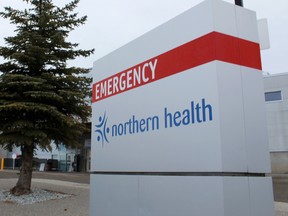Decriminalizing possession and use of hard drugs doesn’t mean we can’t set any rules at all. Why would it?

Article content
Had news broken just a couple of days earlier about British Columbia’s latest misadventure in harm reduction, it would have been indistinguishable from an April Fool’s joke. And like most April Fool’s jokes, it wouldn’t have been funny.
According to a memo leaked to the opposition B.C. United party, nurses in the province’s Northern Health district have over the past year been instructed to allow drug addicts admitted to hospital to use their substances of choice just as they would on the street. (The government has clarified that this policy does not apply to smoking drugs indoors. The harm-reduction lobby may be mighty, but it’s nothing compared to the anti-smoking lobby!) Staff are not to inspect drugs, let alone confiscate them, from patients or their visitors.
Advertisement 2
Article content
Article content
“Staff DO NOT remove personal items from the patient’s room, even if there is a knife or something considered as a weapon under (four inches) long,” the memo admonishes, shifting into full-tilt crazy. “The patient is asked to lock it up or ask someone to bring it home for them.”
The author of this memo seems to share a bizarrely common misapprehension — not unique to British Columbia or indeed to North America — that decriminalizing possession and use of hard drugs (as B.C. did last year) somehow means no rules can be imposed whatsoever on hard drug use. Canada’s many puritanical liquor laws, which persist 100 years after prohibition, ought to be proof enough that’s not the case.
And it’s amusing how the document sets boundaries even as it insists none must be set: The bring-your-own drugs rule is subject to a maximum weight limit, and only to patients over 18, while the bring-your-own knife rule tops out at four inches. Funny rule, no? “Only intervene if the knife is really big”? There are other patients in these hospitals. But “funny” rules are de rigueur in this arena nowadays.
Article content
Advertisement 3
Article content
To be fair to the embattled (unnamed) author of this memo, I can sort of see how a brain captive to Canadian human-rights orthodoxies, and well accustomed to extreme harm-reduction arguments, could arrive at such a policy and defend it — not the weapons part, which is unforgivable and insane (and the government basically admitted as much this week), but the drugs part.
“Ending this program won’t save a single life,“ Mental Health and Addictions Minister Jennifer Whiteside argued in the legislature, and saving lives is (at its most basic and defensible) the only point of harm reduction. One obvious potential scenario: You have someone who desperately needs hospitalization, but avoids it for fear of having to withdraw from addiction. That’s not good news to anyone.
But to that point: Among the harm-reduction programs the NDP government in Victoria continues to defend is “safer supply,” i.e., pharmaceutical-grade opioids prescribed to addicts in hopes of steering them clear from unpredictable street drugs.
Harm reduction as we’ve rolled it out in Canada is a inscrutable mish-mash of going too far and not going far enough
The pitfalls of this approach when it’s poorly managed have been well-documented by National Post columnist Adam Zivo. But one of the charming quirks of Canadian medicare is that if and while you’re admitted to hospital — but not otherwise — the cost of your prescription drugs is almost always covered. Inpatients usually receive their day-to-day prescriptions from the hospital pharmacy, rather than using their own supply from their own pharmacy.
Advertisement 4
Article content
We’re talking about drugs for high blood pressure, for hyperthyroidism, for heartburn, for anxiety, for gout. And we’re going to let opioid addicts consume whatever junk they found on the street, in a hospital, when there’s a perfectly good pharmacy down the hall packed to the gills with pharmaceutical-grade versions of the crap they’re shooting up?
Ridiculous. Harm reduction as we’ve rolled it out in Canada, British Columbia especially, is an inscrutable mish-mash of going too far and not going far enough.
Speaking of going too far: The Ontario Superior Court this week struck down portions of a law, enacted by Ontario’s Progressive Conservative government in 1999, that banned panhandling in certain circumstances: while under the influence of drugs, for example, or to a “captive audience” such as on public transit or in a queue.
There are laws against harassing people, against threatening people, against extorting people, against wandering around in the road with a squeegee and a piece of newspaper bothering motorists. The Safe Streets Act specifically outlaws such behaviour as well, and the judge didn’t touch those portions.
Advertisement 5
Article content
But the idea of banning Canadians from asking their fellow citizens for help always struck me as thoroughly dystopian, including under some of the circumstances now struck down. Where would you ask for help if you were desperate? On a lonely street corner or where there are people who have to see and listen to you? To ban panhandling under the influence, regardless of behaviour, is to exclude some of society’s most vulnerable people simply from asking for help.
Somewhere in this mess of overreaction and backlash, there must be a happy-medium approach to helping Canada’s impoverished, homeless and addicted. The extremists have gobbled up far too much oxygen.
National Post
cselley@postmedia.com
Recommended from Editorial
Article content





